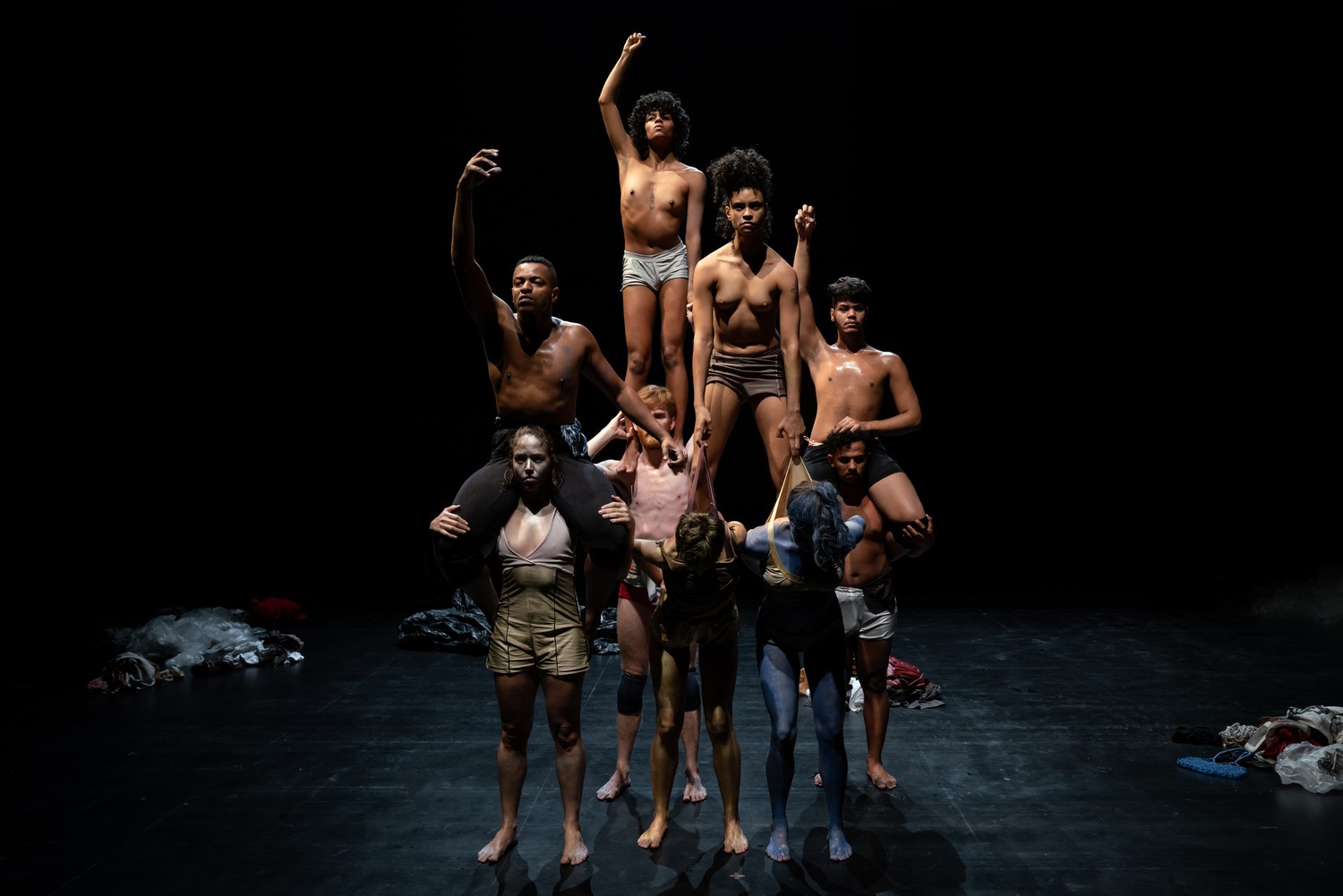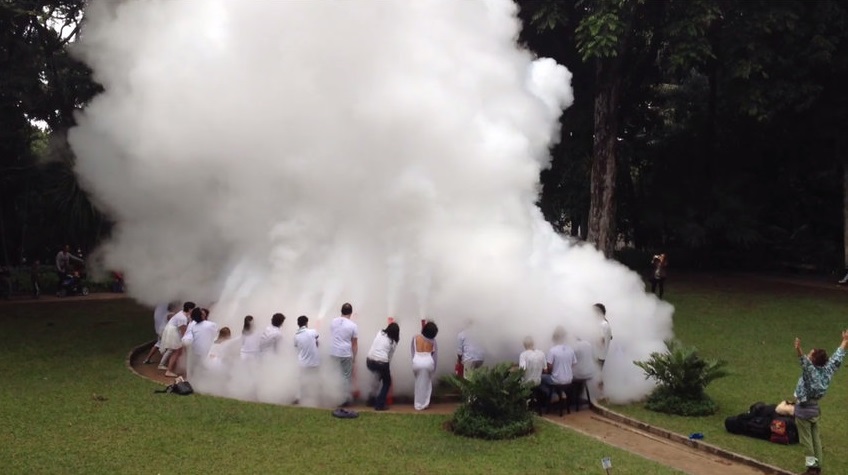Silvia Soter: Lia, you once posed the question, ‘which school for which world?’ What would a dance school for today’s world be like?
A Policy for Dance Is a Collective Construction
12/08/2022
Silvia Soter talks with Lia Rodrigues about dance as a pedagogical and political reflection in today’s Brazil, the principles of the Escola Livre de Dança da Maré, and ways of working with hope as a force of movement.
Lia Rodrigues (São Paulo, Brazil, 1956) is a Brazilian choreographer well-known for her social-critical and socially-charged pieces developed with the Lia Rodrigues Companhia de Danças. She also founded the Panorama Festival and, since 2004, her Company is based in Rio de Janeiro’s favela da Maré, where she has been involved in developing educational and artistic activities in partnership with the non-governmental organization Redes de Desenvolvimento da Maré.

Lia Rodrigues: I think I formulated this question when our school was already in motion here and I was in contact with other dance schools abroad, and I realized that there was a big difference. I think this calls for a bit of context: the Escola Livre de Dança da Maré [Free Dance School of Maré] is a school that operates at the Maré Arts Center, which is located in Rio de Janeiro’s Maré favela. It is a school of professionalization in dance for young people, which also aims to cultivate citizen-artists who are aware of current art and dance issues, who understand where they stand, what they want from this place, where they are headed, and how they can interfere in this social reality. So, broadly, it is a project of citizen formation along with artistic training.
In a country like Brazil, even though there is an established artistic field, why is there no labor market to absorb young dancers?
What labor market does work well in Brazil? There are many jobless engineers and unemployed doctors, working as cabs... so it is a field like any other, which must also be built by these students—because it is a construction. A policy for dance is a construction. I don't think it's a contradiction when we look at the students who went through the School and a high percentage of them found their way into the dance world. But I believe that this applies to any field, not only in the arts; this place is not guaranteed. That is why it is so important that we work politically together with them in this school; they have to get involved in the construction of this place for dance in Brazil, which is what you and I have been doing for almost 50 years.
Supporting this school takes a substantial financial investment from institutions and many professionals engaged in it. What is the investment expected from the students, in terms of time and commitment? Why do you think it is important that they understand what they have to go through?
First of all, they have to understand that a school like this, which offers incredible teachers who are dedicated to them, is free but it’s not gratuitous: they get a scholarship to be here three hours a day, five days a week. It is a very privileged place because, in addition to receiving all the classes, they have time with a psychologist, which is very important for them to understand each other as a group and to talk. The School talks about gender, race, and so on... it is an intersectional place that allows for talking about these issues in a mixed way. So, they must understand that this is a school that they are also building. So, of course, there is the issue of attendance, of the commitment to be here all the time, but that is also an achievement.
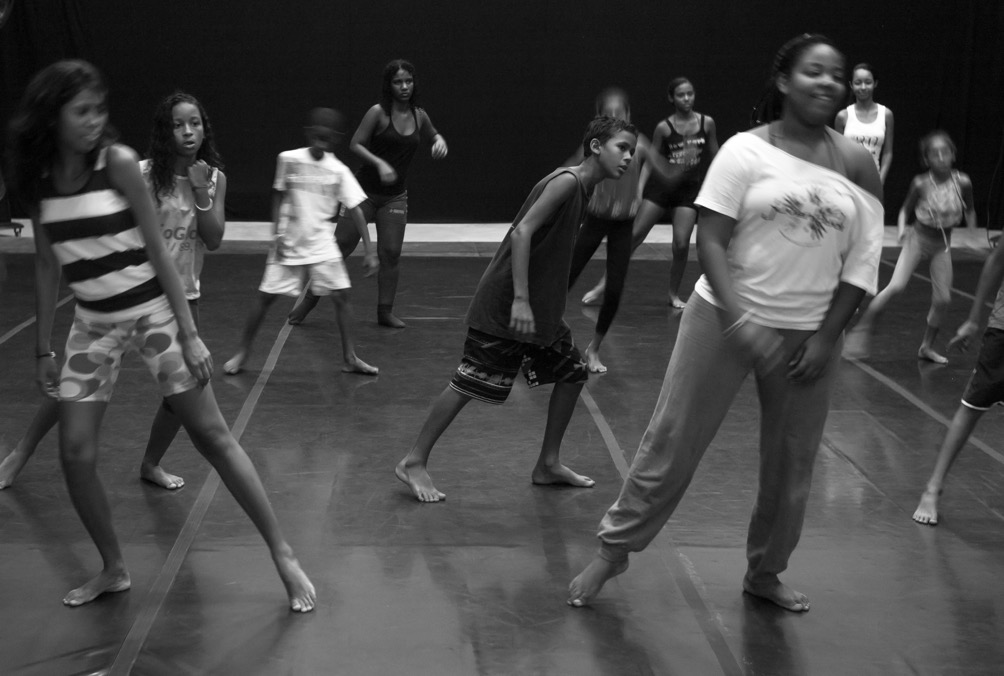

You moved the operations of your dance company—the Lia Rodrigues Companhia de Danças—to Maré between 2004 and 2005. Many years passed and, at some point, arose the desire to create this school. It’d be interesting to know a little about why this school arises as a parallel need while also becoming transversal to the company’s work.
I always wanted to have a dance school that I could frequent but I never managed to get into such a school. So my school was my experience as an artist, as a dancer in the world and here in Brazil. But then I saw what your school—the first dance school in Maré—was like; that was back in 2003 when you introduced me to Redes da Maré. I saw that and I said, "Wow, this school is amazing, this project is amazing! I want to be part of it but I don't know how." Because despite having studied dance, attended ballet school, and done several training programs, I could never consider myself a dance teacher.
But I was interested in pedagogy, in producing artists, which is what I do in my company. Those who arrive at the company are often at the beginning of their career or come from other backgrounds, and I see them flourish in the time they dedicate to it; thus, I began to understand that my work in the company was a formative one, training young artists. I began to realize this and, seeing the project of the first school, I felt that we could combine these two experiences: the training of an artist with a pedagogy of our own.
Let's talk now about the workings of this school that we called a 'free school' when it opened its doors in 2010. How long is the stay and how does it work with the time of the will and the needs of each student?
Our initial idea was for the school to have a Nucleus 1, intended for the people of Maré, which offers various types of classes, such as ballet, hip-hop, contemporary dance, yoga, body awareness, ballroom dance... and also to offer free classes for the neighbors of this area who cannot afford this. So we created a class schedule for residents.
Parallel to that, we thought of having a continuing education group, which currently serves 23 young dancers aged 17 to 25, who follow an intensive training program—as I mentioned—three hours a day, five days a week, and they get a scholarship. This is the Free Dance School that operates at the Maré Arts Center.
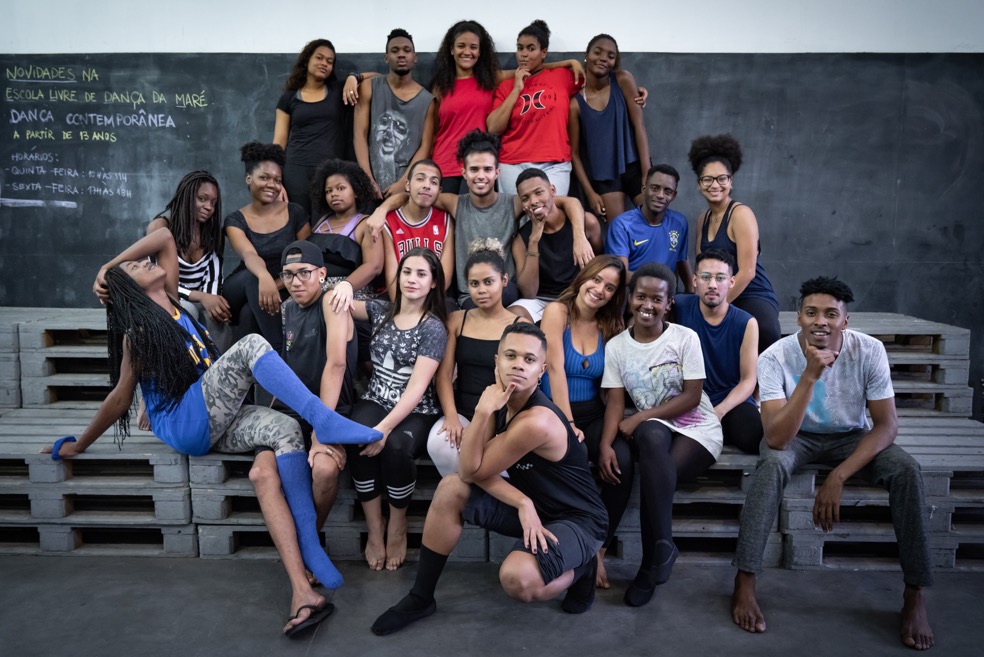
Sometimes, there is a closer relationship between these young students from the school with the work of the dance company. Could you talk about some of these converging experiences and exercises?
Especially the Nucleus 2 of the school is very linked to the company, in the sense that we discuss the classes together, talk about their training, and I can contribute as an artist in that sense. You brought the idea of making some artistic pedagogical exercises, the first of which was Exercício M, de Movimento e Maré [Exercise M, for Movement and Maré]; I took some parts of a work of mine, Aquilo de que somos feitos [Such Stuff As We Are Made Of], and mixed them with the interests of the students. Together, we created a show that was presented many times, but always in a pedagogical context; that is, it wasn’t a show for selling but for sharing with the public, framed in the idea that a dance show can also be a moment of reflection on training and pedagogy.
This is closely related to your own company since as you say, the work there is quite formative. So, this methodology was transposed onto the young artists...
Yes, then there was another exercise, Exercício P, de Pororoca e Piracema [Exercise P, for Pororoca and Piracema], where we used creative structures from two of my pieces—Pororoca and Piracema—to create another exercise and then share it with the public. After Exercício P, we developed a very fond relationship with the French choreographer Maguy Marin, who then gave us the rights to perform May B, which is a classic work of contemporary dance. I worked with her and she told me, "Lia, I want to make this donation to the school." So we staged May B here with students of the Free School, and they even made a small tour around Europe and came back.
Now, our next exercise will be E de Esperançar, Experimentar [E for Experimenting, Hoping-doing]. It seemed so beautiful to me what you proposed for the letter E, Silvia: Hope, departing from Paulo Freire’s idea that hope is something that we expect, that we wait for standing still, he proposes a new verb that implies movement: esperançar—hoping-doing. How do we work with our hope in movement? That is: to create, to do concrete things, to bet on them. And for that experience, which is still to be made, perhaps we will use some structures from Encantado [Enchanted] and Fúria [Rage], which are my two most recent pieces; but we are going to build this all together, which is how I always work. So, these are the exercises we do: creative exercises with a pedagogical inclination.
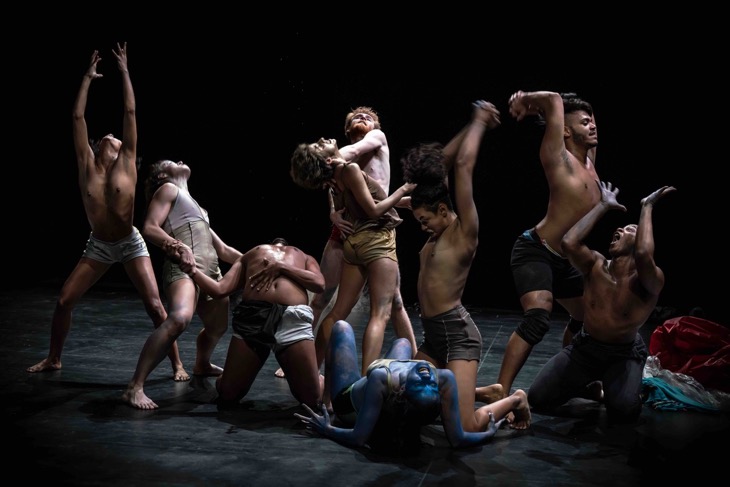


Could you talk a little more about the formative aspect of the company? What does it mean to be a company dancer today, from a formative point of view? What kind of commitments do the young dancers who join in acquire? How do they shape it as artists?
There is something about the experience, about age, that is very funny. The dancers are getting younger and younger—of course, also because I'm getting older too. I'm almost 67 now, and the other day I realized that I'm the same age as the great-grandmother of one of our students... not even the grandmother! So when these artists come along, they may even have done a lot of creative work, but time is an essential experience. I try not to say that, I try to share because my experience is something that they can drink from. They come here from different backgrounds, from different places, and I open the doors for them to help me reinvent myself, as I’m always open to re-creating myself, and also for them to assert themselves, to learn here.
I always tell them that when they come in here, it is important for them to understand that the company is not just about doing the dance work: it has a concept, an ethic for doing dance in Brazil. It is intimately linked to this place, to Redes da Maré and the School. So, when they work in the company, it is not simply about doing the job and making their money; that money gets multiplied here.
Sometimes, that understanding doesn't come so fast for outsiders because sometimes it takes time to understand how this politics is woven; it is different from being an artist without a critical standing. And this is what I want to do as an artist: to work in this way within this territory. I am an artist who, in the last 20 years, has sought to cross her works with pedagogy, training, and with this place called Maré.
Your classes often begin with a conversation: with a long presentation, with texts, with a provocation of which artists are important for each of the people who are there... Why is this space for reflection relevant? How do this sharing and conversations fit into your creative process?
I think it's always a bit similar. I have given thousands of workshops, for example at the Cndc (Centre national de danse contemporaine) in Angers, which trains dancers in France, I worked for a year with the same dancers, and we put together a play based on that; the same happened in Lisbon and many other places. I have identified this way of creating a shared territory, of provoking these young people... and I just stay there stitching and provoking, so that they get organized. In all the experiments, we create something together. But it is not me who is going to create it, it is them.
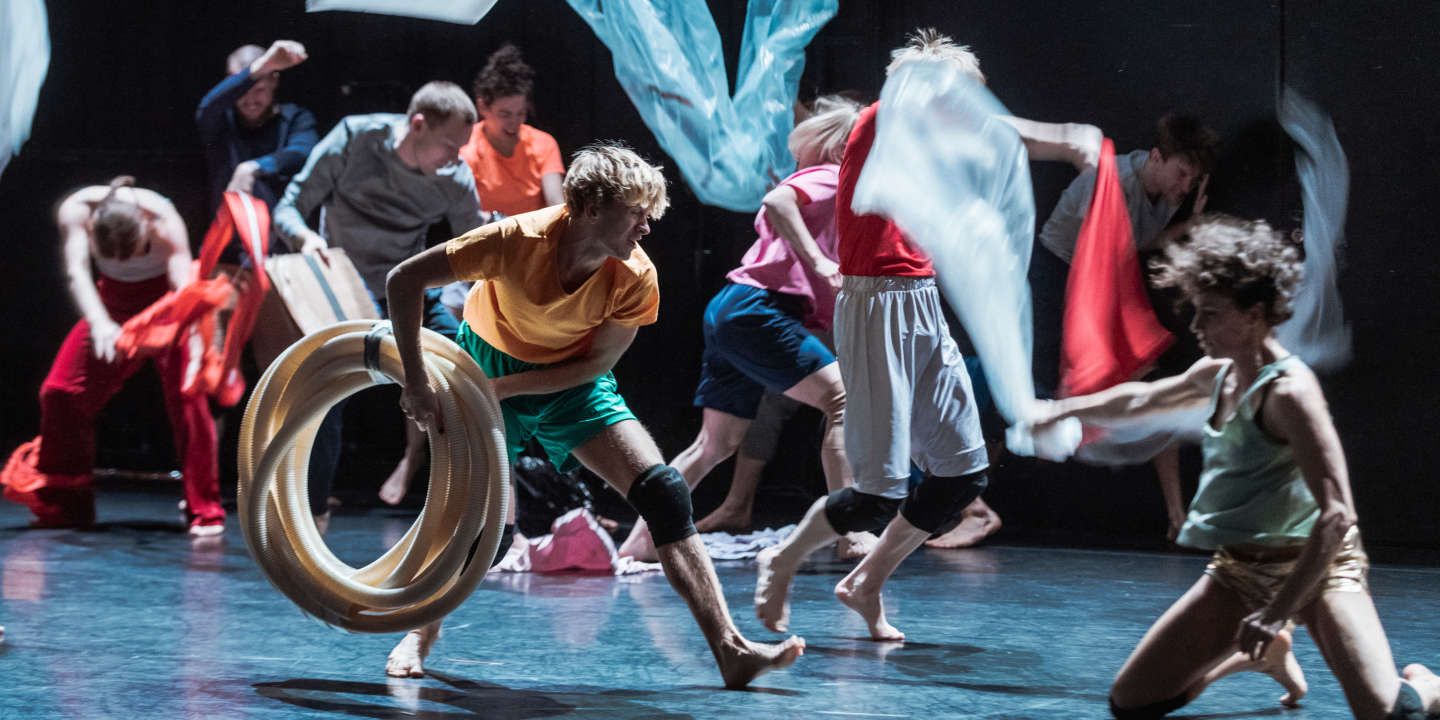
You have a Freirian perspective in that sense; you're not a traditional dance teacher. And this place of autonomy is very powerful for a teacher to provoke someone.
People get upset a lot because they’re used to receiving a gift.
Banking education... as if people were an empty box into which we deposit knowledge.
Yes, and I always say, "Look, I don't have a gift for you, we will have to build this idea together." I don't know what it is, but actually, you've already seen that I-don't-know-what-it-is. I work very hard to not know, to be able to say "I don't know what it is." I fill pages and pages writing the things I'm thinking; I prepare a lot to be in this position, to be prepared for whatever comes. Then, when the class is over, I write everything down: "oh, I didn't say that, let's talk about this;" I outline charts for myself, so I can be in this situation as a teacher. This is a position that makes me very vulnerable, in the same way that I am vulnerable while creating— which I don't think is a bad thing.
It's a vulnerability of the encounter itself, you're not going to impose a project on another. And anything can happen, it can be frustrating or interesting, or neither, it doesn't matter. Your way of working is extremely pedagogical, you work in defense of the ethical and political aim that artists must emancipate themselves.
And take responsibility. I was once working with a company in Norway and there was a moment I had to stop everything and say, "People, this cannot be, you are very spoiled; you have to take a standing, we cannot work like this." Outside Brazil, I always say, "Are you aware of everything you have?” I always bring an idea, I bring books I’m reading, movies... I come with a constellation.
You come from a very different place but you also bring something that allows weaving something else collectively; thus, you need to introduce yourself to others and also be nurtured by them.
I had fantastic experiences of living together that were built with my student; it was a place where people would also gain experiences: they had to go to the market, cook, shop, do accounts, everything... there were arguments... This, for me, was a lesson on how to behave. And I often see artists joining the company who don't have that experience, so sometimes there is friction. It's the experience of taking responsibility for the place where you chose to be.
I'm going to close with a question that requires explaining a little more about the context first: Maré is a popular neighborhood, a complex encompassing 16 favelas in Rio de Janeiro, which is perceived as a peripheral area although it is on the way to the Galeão International Airport, right on the side of one of the main access roads to São Paulo. However, it is a place that the people who live in the most privileged areas of the city do not visit. Since you arrived at the Maré Arts Center, I have come to understand a dimension of your work that is pedagogical and also formative, which is building up an audience. This year, Fúria—a 2018 show—was presented for the first time in Rio; also your most recent creation from 2021, Encantado. You present these works that premiered and toured in Europe at the Maré Arts Center... How does this operation work? What is your interest in making the public come all the way to Maré to have access to these shows?
From the beginning of my relationship with Redes, I realized that I would have to take this name of Maré and Redes da Maré everywhere, and I’ve been trying to do that ever since. You saw it, we worked a lot in France and we had to be very didactic in explaining. Because I asked myself, what can I do? I can take this name, this relationship, to the world outside. Why outside? Because that's where the money is. I find it sad, for example, that I always perform here and I had no support from the Municipality or the Secretary of the State for this season, which I think is very important for the city of Rio de Janeiro.
As you said, these two works have toured around the world, and here, we have no support, we do it in collaboration with Redes and with a lot of will on our part. But I believe in you Silvia, and I believe that the people who live in the south of the city, which is a protected place, need to come here and understand that the world and art exist beyond that place... Art must be democratized. In my opinion, artists need to be immersed in the current moment of their world. I am a white woman with many privileges, so I thought, what can I do with my privileges? My privileges equal my responsibility. And how do I harness that responsibility? I do it in all my projects, not only in the collaboration with Redes, with the Art Center, and the Free School but also within the company. I think that the people who make art in southern Rio must understand that this place exists as well, that there are artists here too, artists from Maré, who develop their work, their way of thinking about the world, who also matter and deserve to be seen, heard, and shared. I use my company to create this mix of artists from Maré and from the company with the public of Maré.
I see this in time... for us, there is no time. The time for learning will not end; the time for creating will not end, the time for building a school and an arts center will not end. That time is endless because that is life. And although I still have a few years ahead of me, I will come to an end, but I hope that this work will remain, that it will have continuity.
You see, today we have a government that has destroyed all the foundations of education, in addition to destroying the Amazon, leading this country to starvation, cutting all investment in universities... Therefore, we see how important it is that we remain here resisting. I could leave, there are many job opportunities, but it is here where we have to stay because there is still a lot to build.
